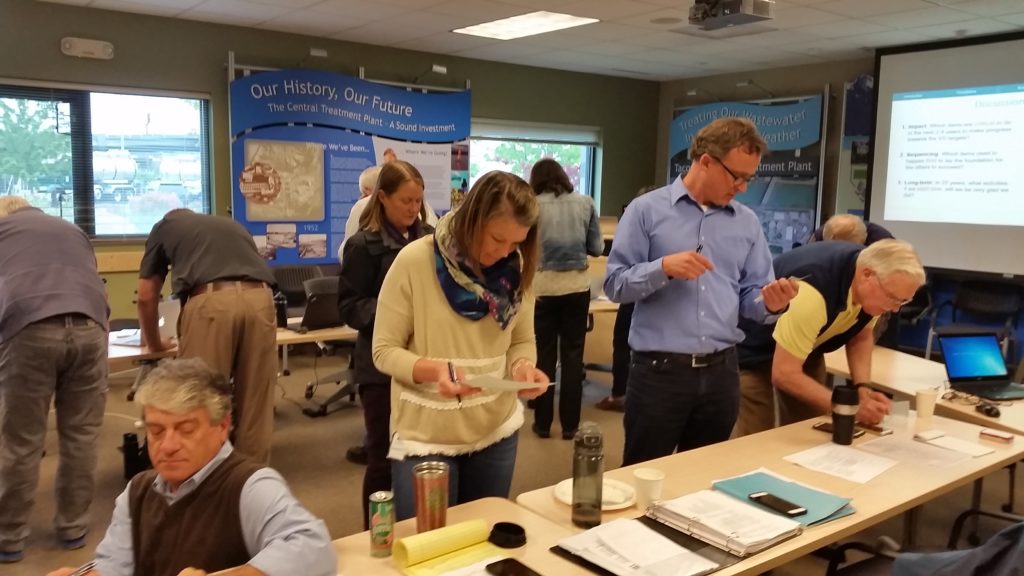The region’s plan for the next four years
The Puget Sound Action Agenda is the heart of our regional recovery strategy, outlining the vision for Puget Sound restoration and protection. The Action Agenda is updated periodically with a new Implementation Plan that describes the short term goals and all of the great ideas around the Sound for projects that align with those priorities.
We are currently implementing the 2016 Action Agenda, which will last until 2018. Because of a recent decision by the Washington State Legislature, the new Implementation Plan in 2018 will last through 2022, changing from a two-year to a four-year cycle.
The regional priorities for the Implementation Plan are important to all the Puget Sound partners and stakeholders because they define the scope of the activities (near-term actions) that will and will not be included in the Action Agenda, which affects projects’ eligibility for some funding sources, including EPA Geographic Funds.
The challenge of focusing and prioritizing
It takes time, energy, and a lot of thoughtful collaboration to define what the region will focus on in the near-term. The priorities need to be strategic: focused and honed in on key activities that will push Puget Sound recovery forward. However, they also need to be broad enough that we don’t drop the ball on important work we’re already doing, and they need to be scoped to fit and last the four-year period.
What’s more, different geographic areas around the Sound have different local priorities and are at different stages in the recovery process. The regional Implementation Plan needs to be crafted to sync with and advance these varied local efforts, so everyone involved in Puget Sound recovery is making the most strategic near-term steps.
The Puget Sound Partnership (the Partnership) is tasked with developing and updating the Action Agenda, including its Implementation Plan. Because the agency partners involved in the Strategic Initiatives are tasked with implementing and funding work prioritized in the Action Agenda, we are critical, close collaborators with the Partnership in developing the 2018 plan.
Focusing on specific issues in Puget Sound
In early 2017, the Puget Sound Leadership Council decided on an area of focus for 2018-2022. This area of focus includes 10 issues, called Vital Signs, and 7 of those 10 issues are connected to ongoing work in the Strategic Initiatives:
- Habitat
- Estuaries: Refining the existing strategy for restoring estuary area and connectivity
- Floodplains: Refining the existing strategy for protecting and restoring area and function of floodplains
- Land Development and Cover: Refining the existing strategy for protecting critical ecological areas while encouraging strategic urban infill
- Shoreline Armoring: Developing the strategy for net decrease in hard armored (bulkhead-blocked) shoreline
- Stormwater
- Freshwater Quality (BIBI): Developing the strategy for decreasing amount of runoff that harms invertebrate health and diversity
- Freshwater Quality (Toxics in Fish): Preparing to develop the strategy for decreasing polluted runoff that ends up in fish
- Shellfish
- Shellfish: Refining the existing strategy for decreasing fecal bacteria pollution that makes shellfish unsafe to harvest and eat
We worked with our Advisory Teams to develop priorities
Once the Puget Sound Leadership Council decided on the topics for focus, we were tasked with figuring out priorities for each topic associated with our Strategic Initiative. Thankfully, we had many resources at our disposal to help us develop and refine the priorities:
- We relied heavily on the Implementation Strategies to determine the most critical steps the plans say the region should take to meet the recovery goal.
- We looked at the most recent drafts of local recovery plans to learn about local priorities. We talked with Local Integrating Organization coordinators and worked with them to learn more about local approaches and concerns.
- We talked to other partners working on the issues to learn about their work and see how it fit with the approaches suggested by the Implementation Strategies.
- We looked back at past Action Agenda priorities and reflected on their continued relevance or need for improvement.
Then, we convened our Advisory Teams to sort through all we learned. The Advisory Teams applied their technical expertise on the topics, as well as their diverse geographic and institutional knowledge, to help shape the priorities into a cohesive list of approaches for each topic.

Often, for a given priority approach, an Advisory Team had suggestions that would help stakeholders improve a projects’ effectiveness and reach. For instance, they sometimes recommended a key partnership or an important dataset. We used this guidance to refine the priorities with “considerations” or “proposal guidance.”
Our teams collected all we learned from our Advisory Teams and compiled the draft list of regional priorities, working together and with our partners in the Action Agenda Coordination Group to prepare the draft for public review.
Public review and next steps
In early July, the Puget Sound Partnership released the priorities for public review. Our teams are currently reviewing and responding to all the thoughtful feedback provided during the comment period, which closed in mid-August. We are working with our Advisory Teams to address outstanding issues and continue to improve the content of the priorities.
Once the priorities are finalized and approved by Puget Sound Partnership and its Leadership Council, there will be a solicitation for near-term action ideas. Stay tuned if you are interested in submitting your project idea for the 2018-2022 Action Agenda!

